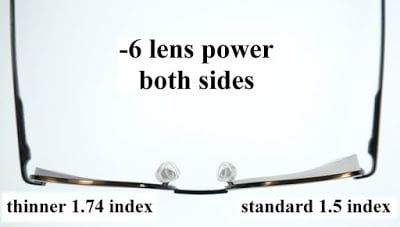
High index lenses for eyeglasses are the best choice if you have higher power thick lenses and you want thin lenses also have lightweight and comfortable while wearing. Before moving to the higher index lenses features you have to know about what is the index of a lens?
Table of Contents
What does lens index mean?
Lens index means the refractive index of a lens. The Refractive index of a material is a dimensionless number that tells us how fast the light travels through the material. In other words, the index of the lens is the ratio of the speed of light in a vacuum divided by the speed of light in the lens material. The refractive indexes of the ophthalmic lenses range from 1.50 to 1.74.
What are High Index Lenses?
High index lenses are those lenses whose refractive index of the lens is higher than the common ordinary lenses having a 1.50 index. The ophthalmic lenses above 1.59 refractive index are considered as high index lenses. These lenses are available at 1.6, 1.67 and 1.74 indexes.
In summary, the Higher the index thinner will be the lenses and the lower the index of lenses thicker will be the eyeglasses lens.

Inpatient wearing high plus power prescription lenses which are thick can enlarge the appearance of eyes which is known as bulging eye syndrome, it makes the eye look like they are bulging out due to wearing high plus power thick lens, and in high minus prescription on myopic patients the thick minus lenses minimize the appearance of eyes and patient’s facial contours looks narrower behind the glasses. Both effects are very undesirable and unattractive, so the option to minimize this type of effects is by using High index lenses.
Eyeglass lenses correct people’s eyesight by bending the light as it passes through the lens glass. How much the lens bends the light is called the lens power, and this is what your eyeglass prescription usually indicates. Most eyeglass wearers are Myopic i.e. nearsighted, meaning their lenses are curved with thin centres and thick edges. The stronger the prescription, the thicker the edges. For people with particularly strong prescriptions, this can result in the infamous “bottlecap” lenses, with particularly thick edges that are cumbersome and aesthetically unappealing. With today’s modern styles featuring thin rims, these thick lenses are even more problematic.
Is High Index eyeglass lenses are right for you?
High-index eyeglass lenses are the right choice if you want thinner, lighter lenses and eyeglasses that are as attractive and comfortable as possible.
Hi-index lenses are perfect for the followings
- People with Plus or minus two (+/- 2.00) prescription power or stronger prescriptions
- who are self-conscious about the thickness of their lens.
- wearing contact lenses because traditional lenses distort their vision.
Higher the index, the thinner the lens.

Advantages
- Thinner: Due to having a high refractive index it bends more light.
- Lighter: Thin lens means lens made with less material, less material have less weight.
- Comfortable: Thinner and lighter lens provide comfortable eyeglasses wearing experience.
Disadvantages
- Expensive: Higher the index higher the price of the lens due to the expensive manufacturing process.
- more prone to scratches: Less durable
- More reflective: Needs Anti Reflection coating to minimize this problem.
Regular Lens vs. High Index Lens
Compared to the regular lens the high index lens has more index that is the regular lens having an index of 1.50, 1.52 etc and a high index lens start from 1.60 to 1.74.
Regular lenses are heavier and thicker as compared to high index lens. The price of regular lenses is cheaper than the price of high index glasses. Compared to conventional lenses, High Index is up to 40% thinner.

Available Options
- Standard/Regular Lens: 1.5 index lens
- Mid Index Thin and Light Lens: 1.56 index
- Polycarbonate Lens: 1.59 index
- Super-thin Lens: 1.6 index
- Ultra-thin Lens: 1.67 high index lens
- Thinnest and Lightest Lens: 1,74 high index lens
What Vision Problems Do High-Index Lenses Correct?
These lens correct myopia, hypermetropia and astigmatism. They are available in single vision lens and also in the progressive lens to correct presbyopia.
Choosing the Right Frames for high prescription
When you have a high prescription, it’s very important to choose a frame that provides you best style and comfort. If you have a strong power prescription the rimless frame may not be the best option for you even with a high index lens. The best frame for high power is a small rounded frame or an oval frame, which provide better fitting of the lens as well as minimize the distortion caused by the lens with higher prescription.
High Index Lens in Nepal
High index lens is not easily available at all optical shops of Nepal, only major optical outlets that sell premium brands of the ophthalmic lens in Nepal will tell you detailed information about the availability in Nepal.
The price of a high index lens in Nepal initially starts from NPR 6,000 (USD 52) for 1.60 indexes, NPR 9,000 (USD 78) for 1.67 indexes and NPR 16,000 (USD 138) for 1.74 indexes, depend upon the additional coating the price may go higher.
To know more information about those lens sends us a message on our Facebook page. It came with a different index, the price will depend upon the power and index if you choose a higher index price will also go higher.
https://www.facebook.com/eyehealthinfo
You can ask your optometrist, or eye health professionals to find out if high-index glasses are your best option for prescription lens and their prices.


